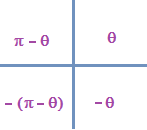Complex Numbers
Any number of the form x + iy where x, y ϵ R and i² = -1 is called a complex number.
In the complex number x + iy, x is called the real part and y is called the imaginary part of the complex number.
A complex number is said to be purely imaginary if its real part is zero and is said to be purely real if its imaginary part is zero.
Two complex numbers are conjugate if their sum and product are both real. they are of the form a + ib, a – ib.
cisθ₁ cisθ₂ = cis (θ₁ + θ₂)
cisθ₁/ cisθ₂ = cis (θ₁ – θ₂)
1/ (cos θ + i sin θ) = (cos θ – i sin θ)
\(\frac{1+i}{1-i}=i,\frac{1-i}{1+i}=-i\).
√(x² + y²) is called the modules of the complex number x + iy and is denoted by |x + iy|.
Any value of θ obtained from the equation cos θ = x/ r, sin θ = y/ r is called an amplitude of the complex number.
The amplitude lying between -π and +π is called the principle amplitude of the complex number. If θ is the principal amplitude, then -90 < θ ≤ 90.

If α is the principle amplitude of a complex number general amplitude = 2nπ + α, n ϵ Z.
Example: If z = 3 + 5i then show that z³ – 10z² + 58z – 136 = 0.
Solution: Given,
z = 3 + 5i
z³ – 10z² +58z – 136 = 0
L.H.S = z³ – 10z² +58z – 136
(z – 3)² = (5i )²
z² – 6z + 9 = – 25
z² – 6z + 9 + 25 = 0
z² – 6z + 34 = 0
z².z – 6z.z + 34.z = 0
z³ – 6z² + 34z = 0
Add and Subtract 4 (z² – 6z + 34)
z³ – 6z² + 34z + 4 (z² – 6z + 34) – 4 (z² – 6z + 34) = 0
z³ – 10z² + 58z – 136 + 4 (z² – 6z + 34) = 0
We know that (z² – 6z + 34) = 0
z³ – 10z² + 58z – 136 + 4 (0) = 0
z³ – 10z² + 58z – 136 = 0
